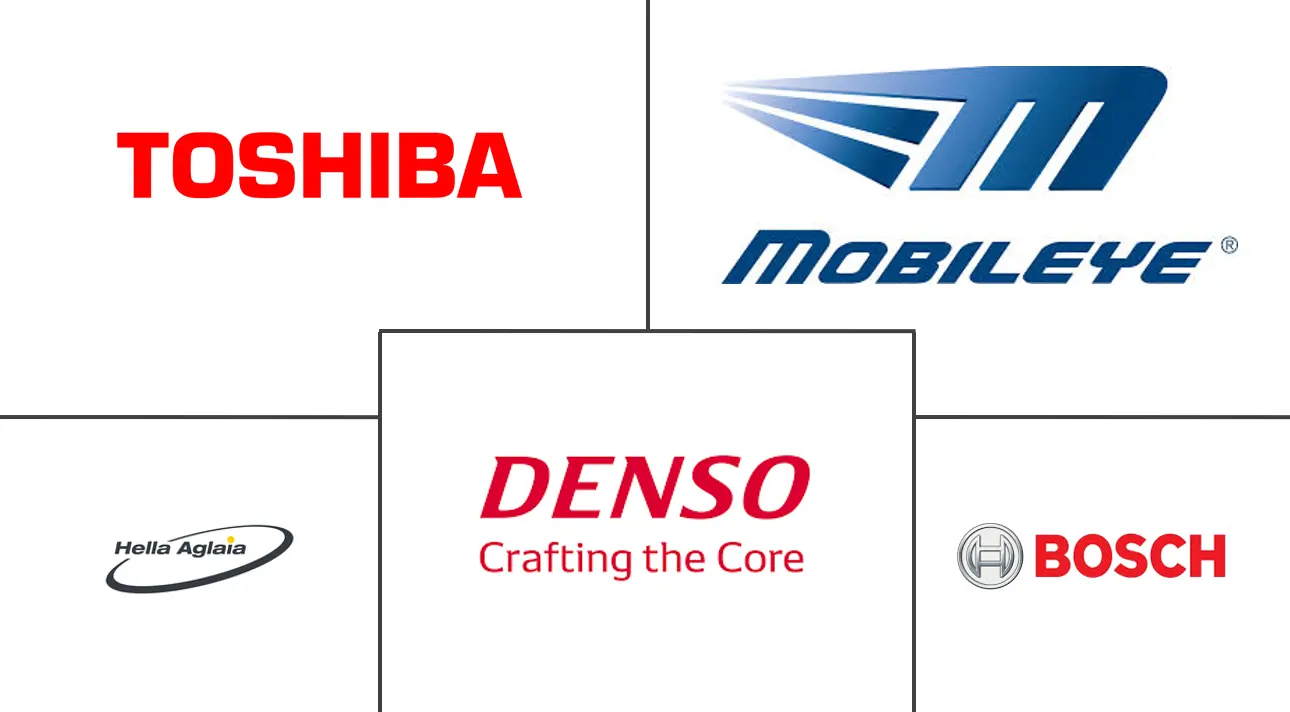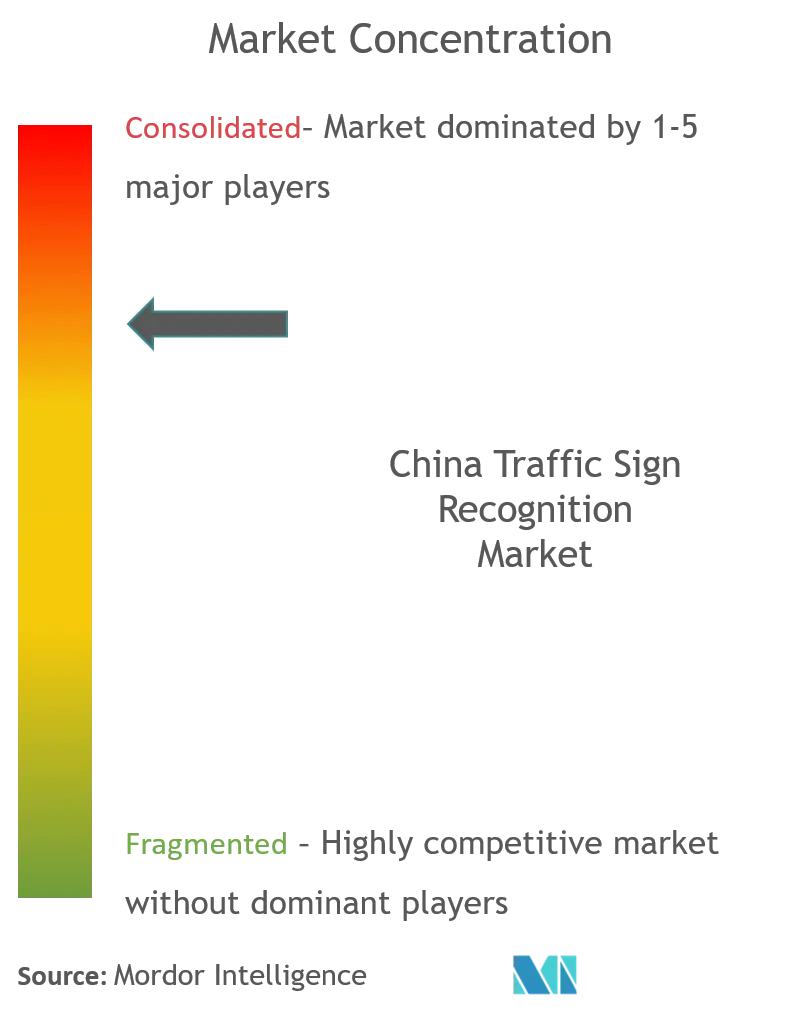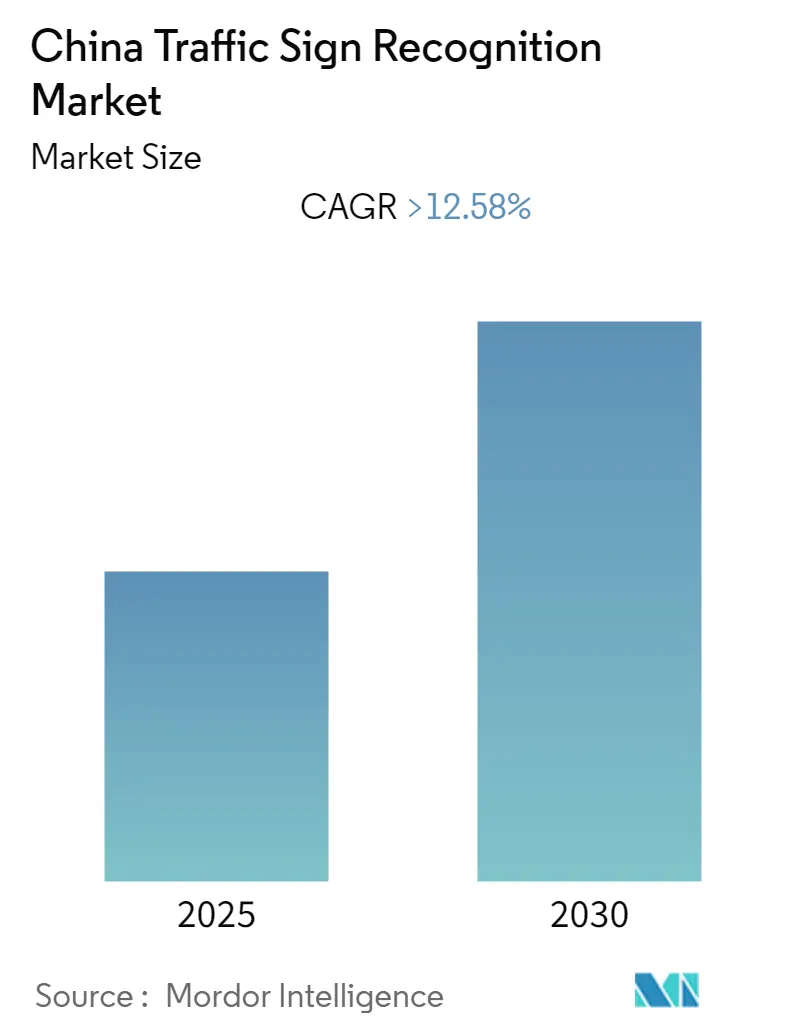
China Traffic Sign Recognition Market Analysis
The China Traffic Sign Recognition Market is expected to register a CAGR of greater than 12.58% during the forecast period.
- Traffic sign detects traffic signs with a multifunction camera and assists the passenger by displaying detected speed limits and overtaking restrictions in the instrument cluster. If the system detects that a passenger is driving onto a section of the road in the wrong direction, it triggers a warning. The camera also detects traffic signs with a restriction indicated by an additional sign.
- Intelligent transport systems (ITS), an umbrella term to describe policies that ease the processes of traffic and driving through automation, have evolved to include traffic recognition systems (TSR), which enable automatic traffic sign detection and recognition. Given the rate of deaths and casualties resulting from human errors on the roads, the employment of this technology, in combination with active human-machine interfaces, is likely to reduce the accident rates dramatically.
- While most manufacturers are integrating sensors and cameras for traffic sign detection and recognition in new cars, other sensors-based companies are offering add-on sensors, which can be used in cars without pre-installed pedestrian detection systems, including Mobileye.
China Traffic Sign Recognition Market Trends
Rise in Stringent Government Regulations and Growing Demand for Autonomous Vehicles
- The number of on-road accidents is increasing rapidly, and it is estimated that, on average, every single road accident results in at least two deaths and five serious casualties. According to the World Health Organization, nearly 1.25 million deaths occur due to road accidents annually. The efforts of various governments to reduce fatalities from road accidents have led to increased safety standards in new vehicles.
- Organizations involved in car safety regulations focus on ADAS for enhanced safety of passengers and pedestrians. The American New Car Assessment Program (NCAP) and the European New Car Assessment Program (Euro NCAP) have made certain features of ADAS mandatory in new vehicles.
- Audi, Ford, BMW, Mercedes, Volvo, and Honda are some of the major companies deploying the traffic sign recognition system in their vehicles. With the ongoing technological advancements in the traffic sign recognition system, the demand for components like processors and image-sensing cameras are likely to increase and is expected to drive the market.
- The growing demand for autonomous vehicles is driving traffic signal recognition, as the development of semi-autonomous vehicles is expected to continue till the end of this decade. With the expansion of urban autopilot systems, the vehicles are expected to go fully autonomous by the end of 2025. These features can reduce the fatalities due to road accidents by up to 80%.
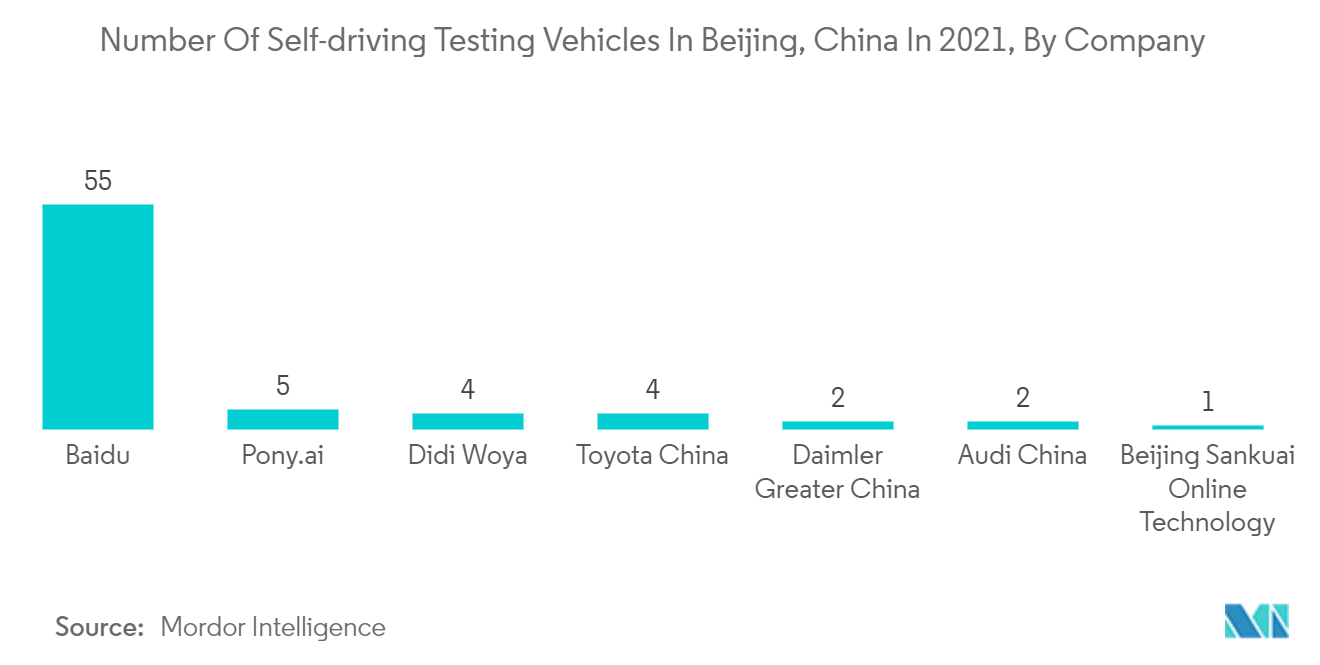
China to be Driving the Traffic Signal Recognition Market
- China continues to be the world's largest vehicle market by both annual sales and manufacturing output, with domestic production expected to reach 35 million vehicles by 2025. Based on data from the Ministry of Industry and Information Technology, over 26 million vehicles were sold in 2021, including 21.48 million passenger vehicles, an increase of 7.1% from 2020. Commercial vehicle sales reached 4.79 million units, down 6.6% from 2020.
- China's rapid technological advancements and growing automotive industry have positioned it as a driving force in the traffic signal recognition market. Traffic signal recognition systems, also known as traffic sign recognition systems, are an essential component of advanced driver assistance systems (ADAS) and autonomous vehicles. These systems use cameras and sensors to detect and interpret traffic signals, enabling vehicles to respond appropriately.
- China's commitment to innovation and its significant investments in research and development has propelled the country to the forefront of this emerging market. With its large population and increasing urbanization, China faces unique transportation challenges, including heavy traffic congestion. As a result, there is a pressing need for advanced traffic management systems to enhance safety, efficiency, and overall driving experience.
- The Chinese government recognizes the potential of traffic signal recognition system in tackling these challenges and has taken proactive measures to support their development and implementation. Several initiatives, such as the "Made in China 2025" strategy, aim to transform China into a global leader in high-tech industries, including autonomous driving. The government's emphasis on intelligent transportation systems and its willingness to foster partnerships between industry and academia have created a favorable ecosystem for traffic signal recognition system technology.
- China's automotive industry, the largest in the world, has also played a crucial role in driving the traffic signal recognition market. Leading Chinese automakers have been quick to adopt ADAS technologies and integrate them into their vehicle models. These companies understand the importance of traffic signal recognition systemsin enhancing road safety and are actively investing in their research and implementation.
- Furthermore, China's thriving tech sector, dominated by companies like Baidu, Alibaba, and Tencent (BAT), has made significant strides in developing advanced computer vision and deep learning algorithms. These algorithms are the backbone of TSR systems, enabling accurate detection and interpretation of traffic signals. With their extensive resources and expertise, Chinese tech giants are well-positioned to lead the development of cutting-edge traffic signal recognition technologies.
- China's massive domestic market also serves as a catalyst for the growth of the traffic signal recognition market. The increasing number of vehicles on Chinese roads has fueled the demand for ADAS features, including traffic signal recognition systems. As Chinese consumers become more safety-conscious, the market for vehicles equipped with traffic signal recognition technology is expected to expand significantly.
- In addition to the domestic market, China's influence in the global automotive industry gives it a competitive edge. Chinese automakers are expanding their reach to international markets, offering vehicles with advanced ADAS features, including traffic signal recognition systems This expansion provides an opportunity for Chinese traffic signal recognition system technology providers to gain global recognition and market share.
- However, it is important to note that China's rise as a driving force in the traffic signal recognition market is not without challenges. Ensuring the reliability, accuracy, and robustness of TSR systems in diverse road and weather conditions remains a critical area of focus. Additionally, addressing privacy concerns and establishing standardized regulations is essential for widespread adoption and trust in these technologies.
- In conclusion, China's commitment to innovation, its booming automotive industry, and the government's support for intelligent transportation systems have positioned the country as a driving force in the traffic signal recognition market. With its vast market potential, technological prowess, and global ambitions, China is poised to shape the future of TSR systems and play a significant role in the advancement of autonomous driving technologies.
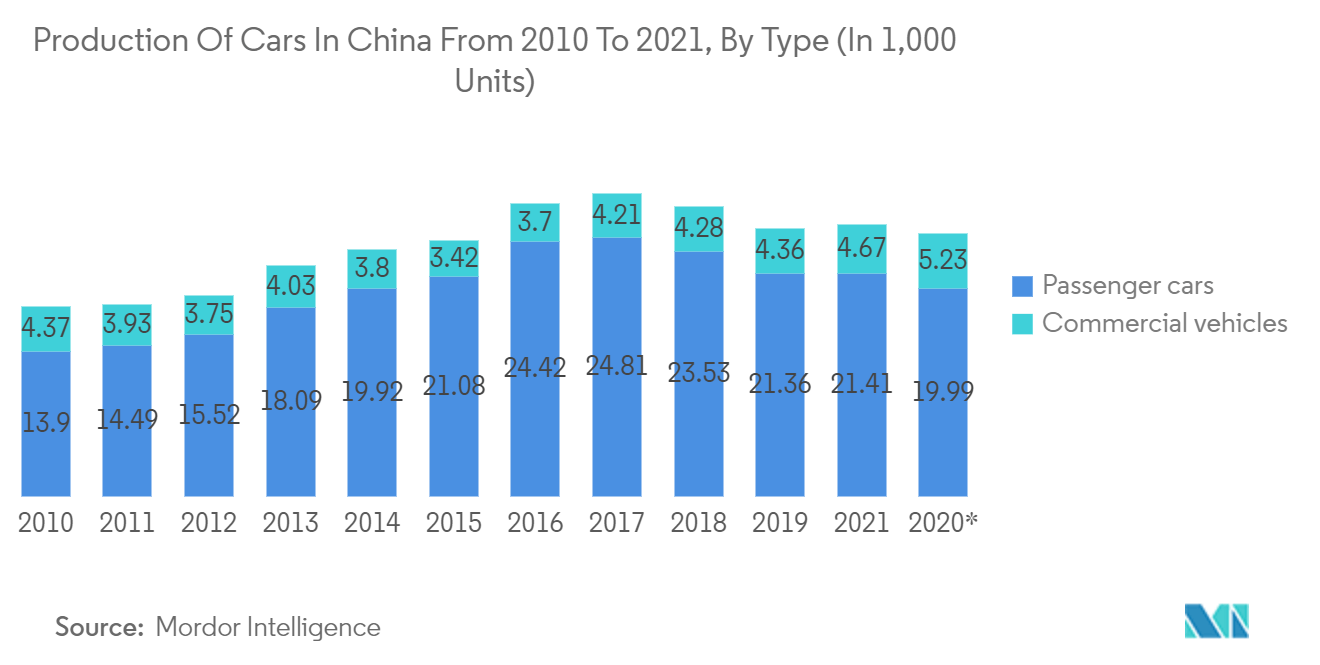
China Traffic Sign Recognition Industry Overview
China's traffic signal recognition market is dominated by a few players, Robert Bosch, Daimler, DENSO Corporation, Continental AG, Toshiba Corporation, and HELLA GmbH & Co. KGaA, among others. The companies are investing in IoT technologies, such as intelligent and connected devices, software platforms, and applications and services, and making partnerships to be ahead in the competition. Technology manufacturers are also focusing on increasing connectivity in mobility and industry, consumer goods, and building and energy technology.
China Traffic Sign Recognition Market Leaders
-
Continental AG
-
Robert Bosch Gmbh
-
Toshiba Corporation
-
HELLA Gmbh & Co KgaA
-
Mobiryr Corporation
- *Disclaimer: Major Players sorted in no particular order
China Traffic Sign Recognition Market News
- April 202: Technology company Continental introduced a new feature called Child-Presence-Detection (CPD) to its digital access system CoSmA. This function is designed to detect children left inside the vehicle and issue a warning.
- March 2023: Toshiba Electronic Devices & Storage Corporation launched the initial two products of its Thermoflagger™ over-temperature detection IC series. The first product, "TCTH021BE," detects abnormal states without a latching function for the FLAG signal, while the second product, "TCTH022BE," includes a latching function. These ICs use positive temperature coefficient (PTC) thermistors in a simple circuit configuration to detect temperature rises within electronic equipment.
China Traffic Sign Recognition Industry Segmentation
An automotive traffic sign recognition system is an advanced automotive technology that detects traffic signs installed on the road and alerts drivers to make decisions accordingly.
The China traffic signal recognition market has been segmented by traffic sign detection type and by vehicle type. The traffic sign detection type segment includes color-based detection, shape-based detection, and feature-based detection. The vehicle type segment comprises passenger cars and commercial vehicles.
The report offers market size and forecasts in value (USD) for all the above segments.
| Traffic Sign Detection | Color-Based |
| Feature-Based | |
| Shape-Based | |
| Vehicle Type | Passenger Cars |
| Commercial Cars |
China Traffic Sign Recognition Market Research FAQs
What is the current China Traffic Sign Recognition Market size?
The China Traffic Sign Recognition Market is projected to register a CAGR of greater than 12.58% during the forecast period (2025-2030)
Who are the key players in China Traffic Sign Recognition Market?
Continental AG, Robert Bosch Gmbh, Toshiba Corporation, HELLA Gmbh & Co KgaA and Mobiryr Corporation are the major companies operating in the China Traffic Sign Recognition Market.
What years does this China Traffic Sign Recognition Market cover?
The report covers the China Traffic Sign Recognition Market historical market size for years: 2019, 2020, 2021, 2022, 2023 and 2024. The report also forecasts the China Traffic Sign Recognition Market size for years: 2025, 2026, 2027, 2028, 2029 and 2030.
Our Best Selling Reports
China Traffic Sign Recognition Industry Report
Statistics for the 2025 China Traffic Sign Recognition market share, size and revenue growth rate, created by Mordor Intelligence™ Industry Reports. China Traffic Sign Recognition analysis includes a market forecast outlook for 2025 to 2030 and historical overview. Get a sample of this industry analysis as a free report PDF download.

